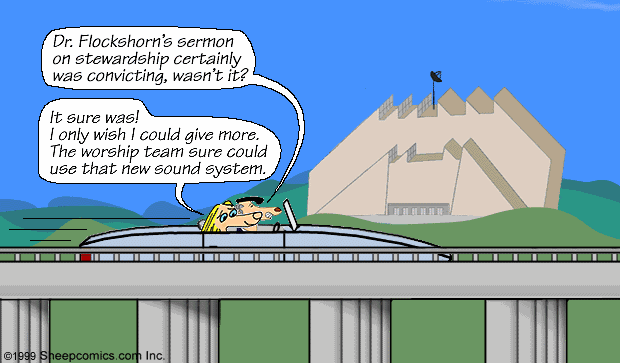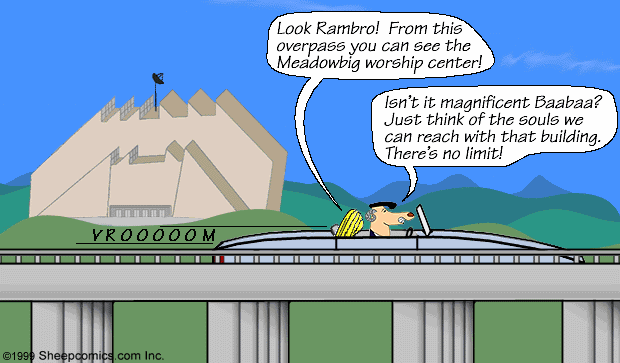


Editorial Notes
Rambro and Baabaa are happily cruising down the interstate when Baabaa notices that the freeway overpass provides an excellent view of the Meadowbig Mainstream “worship center” (that’s what they like to call their building). What Rambro and Baabaa didn’t notice is the mouse that lives under the overpass. Rambro is confident of the unlimited ministry potential that such a facility provides, but the mouse isn’t impressed. (Somehow the mouse overheard Rambro and Baabaa as they drove over him. The mouse must have very sensitive hearing!)
The mouse knows that there actually is a “limit” to the ministry potential of that building. The limit being that it can’t be filled with mice like him. The mouse has nothing, and a building like that cannot be paid for by those who have nothing. Also, the mouse knows that the building is used only to house sheep for 90 minutes a week during their corporate worship service. It may be a “house of the Great Shepherd”, but it cannot be a house for a mouse. If the mouse tried to live in that building, the sheep would call an exterminator.
Church Growth, Then and NowThis strip was inspired by a short newspaper article I read a few years ago. In the city where I lived at the time was a very large church with a large building. This church was about to embark on building an even larger building costing many millions of dollars. In this article, one of the church’s leaders described the great new outreach potential the new building would provide.
Two questions occurred to me after I read that article. First, what is the relationship between a church building’s size and that church’s ability to reach the lost? Also, with literally millions of dollars invested in a property and a structure, who was this church trying to reach?
The answer to the first question is “none”. There really isn’t a relationship between building size and outreach potential. At least not until we force a relationship to exist.
Today there is a system where each believer absolutely must attend an assembly at "corporate headquarters", lasting about 90 minutes, during a three or four hour window of time on Sunday morning. This central meeting place must provide a single room with capacity for each member of the church to sit somewhere comfortably for 90 minutes. (And each member's car must have a place to sit comfortably outside, too.)
This forces a constraint on the number of Christians a particular building can support. The maximum number Christians that can be served by a building is the number of people who can fit in the largest meeting room, multiplied by three (assuming that an absolute maximum of three assemblies can occur on Sunday morning).
Pretty soon church planning begins to sound like the same kind of capacity planning one uses in manufacturing. Lets suppose I manufacture and sell widgets. If my widget manufacturing machines can only run for eight hours a day, and each machine can manufacture 100 widgets an hour, then each machine can produce 800 widgets a day. If I want to manufacture 3000 widgets a day, then I’d better buy at least 4 widget manufacturing machines. If I want to increase capacity to 4000 widgets a day, then I have to buy another machine.
Today, churches are a lot like this. There is a “ritual process” which each member must experience at a certain place during a certain few hours a week. All the members must be in the same place. Time and space are both constraints within which all the members can be processed. We can’t change the alotted time, so if the church is to grow, we must create more space. This means a bigger building.
The Christians of the first century didn’t know that their outreach depended on their ability to finance and construct buildings to meet in. If you read the New Testament, you won’t find a single built-for-the-purpose church building (that doesn’t mean they did not exist, but it’s a good indication that they weren’t essential). Christians met primarily in houses (Acts 2:46, Acts 5:42, Acts 8:3, Acts 20:20, Rom 16:3-5, 1 Cor 16:19, Col 4:15, Phil 1:2). As more and more people became Christians, there were more and more houses available for Christians to meet in. The “building program” took care of itself as the church grew.
We modern American Christians have made faith very complicated and expensive. (Perhaps we’ve had too much money for too long.) Many Christians cannot imagine that a church could be legitimate without a central building complex. For their church to grow numerically, it is absolutely necessary for the real estate investment to grow as well.
This may have worked just fine during the previous century when land was plentiful, but there are many cities in America where land is getting extremely expensive, and it’s all been bought up. It seems that the “build a bigger building” approach to church growth has been priced right out of many cities.
Who is the church trying to reach? Well, in theory it should be “the world”, or all those in the world who don’t believe. In reality, it had better be the right demographic mix of what the world has to offer, because somewhere among those we “reach” had better be the people who are going to pay for the building. We really can’t afford to reach too many poor people with our expensive buildings.
Church Accounting 101For example, lets assume that a building that seats 1000 can be constructed for $5,000,000 (this is a wild guess, it would of course vary a lot depending on property values in any given city). Let’s suppose a 7% interest rate on the mortgage, factor in principle amortization and insurance, and you can easily project a payment of $400,000 a year, or somewhere over $30,000 a month. This means that each man, woman, and child must produce an average of $30 a month, and we have yet to include the salaries for the professionals that manage the programs housed in the building.
The point I am trying to make with all this arithmetic is that there is now a “fixed cost” associated with each individual who comes to believe the Gospel. When we use the “build a bigger building” approach to church growth, we find that there is an average amount of money which must be recovered from each new believer or the church can’t make its payments. A church that filled a multi-million dollar “worship center” with poor people would go bankrupt quickly.
Also, the “build a bigger building” approach runs into practical limitations. Buildings can only be so big. I’ve sat through sermons where the preacher has expressed the wish that someday the entire city the church was in could be led to Christ. Under the current status quo church growth methodology, that would require an auditorium capable of seating hundreds of thousands or millions of people. Of course, we all know that this is impossible. The “bigger is better” church growth plan is bound to be defeated by economics and the laws of physics (not to mention zoning laws).
Have you ever heard of a church split? I have never lived through one, but I’ve heard of them and read about them. It seems that churches have split for innumerable reasons, many having to do with doctrinal issues, or what happens during the “worship service”.
Have you ever heard of a church splitting simply because it was effective in reaching the lost? Has a church ever been so successful in fulfilling the Great Commission that its building was bulging with people, and so half of the members built, bought, or rented a facility a mile or so away and continued the growth? This seems to be one church growth methodology that is unacceptable. It’s also the one with no limits. I hope it’s happened somewhere.
Where is the Worship Center?Another inspiration for this strip comes from the trend among Christians to refer to their buildings as “worship centers”. I don’t think this is wrong, but it is just a little ironic.
In the Gospel of John chapter 4 (20-24) we have the story of Jesus and the woman at the well. The woman raised the issue of where to worship: “this mountain” or Jerusalem? Jesus replied that a time would soon come when the answer would be “none of the above”. Jesus then explained that true worshipers shall worship the Father in “spirit and truth”. These are the people God seeks to be His worshipers.
OK, fine, you may say. Now, just what is “spirit” and “truth”? A book could probably be written on each, and I promised a short editorial. (Short is relative term.)
To provide a short answer to this, I turned to my favorite reference book: Theological Dictionary of the New Testament ; edited by Gerhard Kittel and Gerhard Freidrich, translated by Geoffrey W. Bromiley, abridged in one volume by Geoffrey W. Bromiley; William B. Eerdmans Publishing Company. This book is also known in theology educational circles as “Little Kittle”.
I love this book because it tells me the Greek words behind the English words in the Bible, and because it goes far beyond a simple Greek dictionary or lexicon. It actually tells how the Greek words were understood and used in the Greek World.
First I looked up “spirit” as in John 4:24. The Greek word is “pneuma”, which literally means “wind, breath, life”. (This is probably why a certain dreaded lung disease is called “pneumonia”.)
There is a wonderful sentence here in “Little Kittle” concerning John 4:24, which I quote, “To worship God in pneuma is not to worship in one’s own spirituality but to worship in the world of God and hence of true reality.”
Then I looked up “truth”. The Greek word is “aletheia”. In the book of John, “aletheia” is “authenticity”, “divine reality”, and “revelation”. In other words, it is the reality of God as revealed to us through Jesus Christ.
So, one way of describing what worshipping in “spirit and truth” might be: “worshipping according to God’s true reality as revealed by Jesus Christ”.
Did Jesus reveal to us a god that could be housed in a building? In Acts 7:48, in the speech Stephen gave before being stoned to death, Stephen said that the Most High does not dwell in houses made by human hands. Can a building house “spirit”? Can a building reveal “truth”? Is there a “center” for “worship” under the New Covenant?
Yes, there is. But it’s not something that a bank can finance or that a contractor can build. It’s not a place, and it’s not open just on Sunday morning. Anyone who responds to God according to who He really is might be thought of as a “worship center”. Jesus already paid to build it.
Today the word “worship” is almost synonymous with Christians meeting, but “worship” is never used to describe a meeting of Christians in the New Testament. (Check for yourself.) Today, Christians leave their houses to assemble in “worship centers”. In the New Testament, the “worship centers” assembled in houses. (I thought that was an amusing way to think of it.)
Are church buildings wrong in and of themselves? No. But let’s not give them credit for being anything more than they really are. They are simply structures which allow a lot of people to be in one place and out of the weather. And it seems, from this sheep’s perspective, that they may be preventing the Gospel as much or more than they are promoting it.